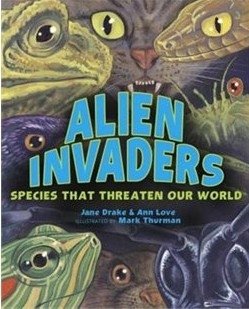Search for Resources
Description
This book provides students with a comprehensive introduction to invasive species and the significant impacts of these species on our natural world. Engaging text that treats the topic like a horror movie highlights how biodiversity is reduced by aggressive non-native species. The reader meets varieties of plants and animals that have changed the face of history. There is also a "top 10" list of the world's most unwanted species. For each plant, insect or animal background information is provided that describes how the species became established, how it spreads, the environmental damage it causes and what is being done to control it. Students will also meet "Eco-guardians" who sound the alarm about hostile species and in some cases almost single-handledly stop their spread. This book teaches students that alien species can cause severe ecological damage and that we all need to be more aware and active in fighting the "invaders".
General Assessment
Recommendation of how and where to use it
Resources for Rethinking has some excellent lesson plans on invasive species such as "Meet the Invaders" and "Alien Invaders". This book and the lesson plans combined make a nice unit on this topic. By combining the lesson plans with the book a teacher can link science and language arts outcomes with other subject areas such as geography, while teaching students about the environmental impacts of invasive species.
This book would also make an excellent companion to an ecosystems unit where students can explain what will happen when an invasive species is introduced into a natural area. If there is a local accessible habitat such as a forested area, students could survey the site for the presence of invasive species. If they find non-native plants or animals they can inventory them and report their results to local conservation organizations. If they do not find invasive species in the area they can brainstorm ways to preserve the area in its natural state, and then create an awareness campaign in the community encouraging everyone to become local "Eco-guardians".
This book could also be used as an introduction to a unit on biodiversity where students describe factors that affect or threaten native species. Students could do some research about how scientific and technological knowledge is being used to help prevent the spread of these species. They could prepare a case study presentation where they identify a particular invasive species, describe its impact and explain how science is helping to solve the problem.
Relevant Curriculum Units
The following tool will allow you to explore the relevant curriculum matches for this resource. To start, select a province listed below.
- Step 1Select a province
- Alberta
- British Columbia
- Manitoba
- Newfoundland & Labrador
- Northwest Territories
- Nova Scotia
- Nunavut
- Ontario
- Step 2Select a grade level
- Grade 4
- Step 3Select a subject
- Science & Technology
- Step 4Relevant matches
- Life Systems: Habitats and Communities
- Grade 6
- Step 3Select a subject
- Science & Technology
- Step 4Relevant matches
- Life Systems: Biodiversity
- Prince Edward Island
- Quebec
- Step 2Select a grade level
- Grade 4
- Step 3Select a subject
- Science & Technology
- Step 4Relevant matches
- Living Things
- Grade 5
- Step 3Select a subject
- Science & Technology
- Step 4Relevant matches
- Living Things
- Grade 6
- Step 3Select a subject
- Science & Technology
- Step 4Relevant matches
- Living Things
- Saskatchewan
- Yukon Territory
Themes Addressed
Ecosystems (3)
- Biodiversity
- Habitat Loss
- Invasive Species

